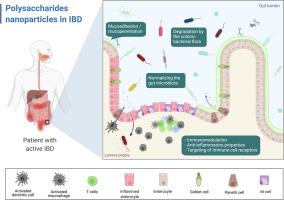Advanced Drug Delivery Reviews ( IF 15.2 ) Pub Date : 2022-01-06 , DOI: 10.1016/j.addr.2021.114101 Hicheme Hadji 1 , Kawthar Bouchemal 1

|
The complex pathogenesis of inflammatory bowel disease (IBD) explains the several hurdles for finding an efficient approach to cure it. Nowadays, therapeutic protocols aim to reduce inflammation during the hot phase or maintain remission during the cold phase. Nonetheless, these drugs suffer from severe side effects or poor efficacy due to low bioavailability in the inflamed region of the intestinal tract. New protocols based on antibodies that target proinflammatory cytokines are clinically relevant. However, besides being expensive, their use is associated with a primary nonresponse or a loss of response following a long administration period. Accordingly, many researchers exploited the physiological changes of the mucosal barrier for designing nanoparticulate drug delivery systems to target inflamed tissues. Others exploited biocompatibility and relative affordability of polysaccharides to test their intrinsic anti-inflammatory and healing properties in IBD models. This critical review updates state of the art on advances in IBD treatment. Data on using polysaccharide nanoparticulate drug delivery systems for IBD treatment are reviewed and discussed.
中文翻译:

炎症性肠病治疗进展:聚焦多糖纳米颗粒给药系统
炎症性肠病 (IBD) 的复杂发病机制解释了寻找有效治疗方法的几个障碍。如今,治疗方案旨在减少热阶段的炎症或保持冷阶段的缓解。尽管如此,由于在肠道发炎区域的生物利用度低,这些药物会产生严重的副作用或疗效不佳。基于针对促炎细胞因子的抗体的新方案具有临床相关性。然而,除了昂贵之外,它们的使用与长期给药后的主要无反应或反应丧失有关。因此,许多研究人员利用粘膜屏障的生理变化来设计纳米颗粒药物递送系统以靶向发炎的组织。其他人则利用多糖的生物相容性和相对可负担性来测试其在 IBD 模型中的内在抗炎和愈合特性。这篇批判性评论更新了 IBD 治疗进展的最新技术。回顾和讨论了使用多糖纳米颗粒药物递送系统治疗 IBD 的数据。











































 京公网安备 11010802027423号
京公网安备 11010802027423号